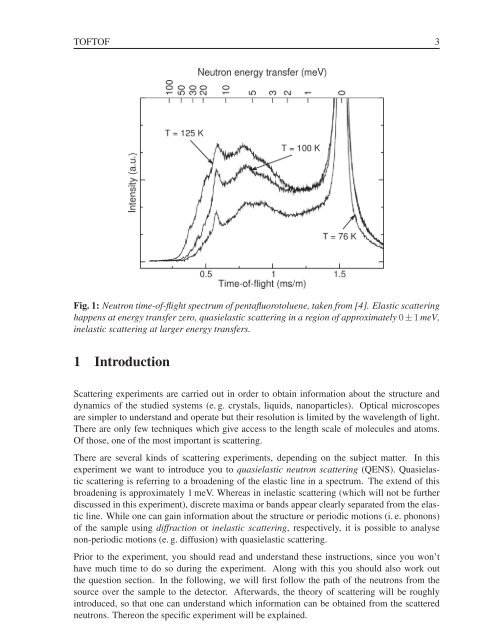Neutron Scattering - JUWEL - Forschungszentrum Jülich
Neutron Scattering - JUWEL - Forschungszentrum Jülich
Neutron Scattering - JUWEL - Forschungszentrum Jülich
You also want an ePaper? Increase the reach of your titles
YUMPU automatically turns print PDFs into web optimized ePapers that Google loves.
TOFTOF 3<br />
Fig. 1: <strong>Neutron</strong> time-of-flight spectrum of pentafluorotoluene, taken from [4]. Elastic scattering<br />
happens at energy transfer zero, quasielastic scattering in a region of approximately 0 ± 1 meV,<br />
inelastic scattering at larger energy transfers.<br />
1 Introduction<br />
<strong>Scattering</strong> experiments are carried out in order to obtain information about the structure and<br />
dynamics of the studied systems (e. g. crystals, liquids, nanoparticles). Optical microscopes<br />
are simpler to understand and operate but their resolution is limited by the wavelength of light.<br />
There are only few techniques which give access to the length scale of molecules and atoms.<br />
Of those, one of the most important is scattering.<br />
There are several kinds of scattering experiments, depending on the subject matter. In this<br />
experiment we want to introduce you to quasielastic neutron scattering (QENS). Quasielastic<br />
scattering is referring to a broadening of the elastic line in a spectrum. The extend of this<br />
broadening is approximately 1 meV. Whereas in inelastic scattering (which will not be further<br />
discussed in this experiment), discrete maxima or bands appear clearly separated from the elastic<br />
line. While one can gain information about the structure or periodic motions (i. e. phonons)<br />
of the sample using diffraction or inelastic scattering, respectively, it is possible to analyse<br />
non-periodic motions (e. g. diffusion) with quasielastic scattering.<br />
Prior to the experiment, you should read and understand these instructions, since you won’t<br />
have much time to do so during the experiment. Along with this you should also work out<br />
the question section. In the following, we will first follow the path of the neutrons from the<br />
source over the sample to the detector. Afterwards, the theory of scattering will be roughly<br />
introduced, so that one can understand which information can be obtained from the scattered<br />
neutrons. Thereon the specific experiment will be explained.

















